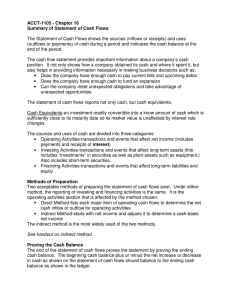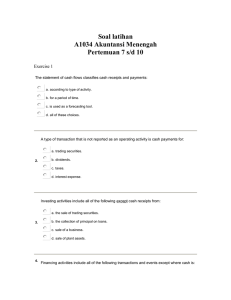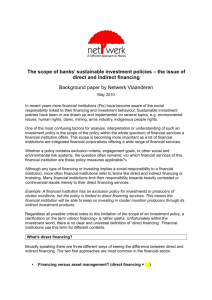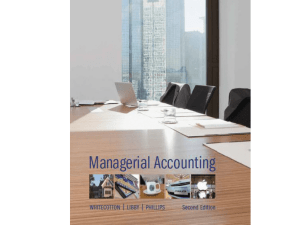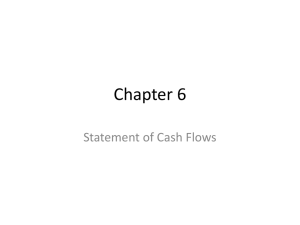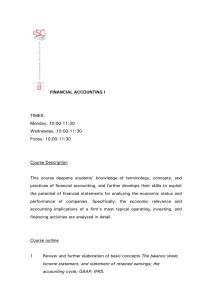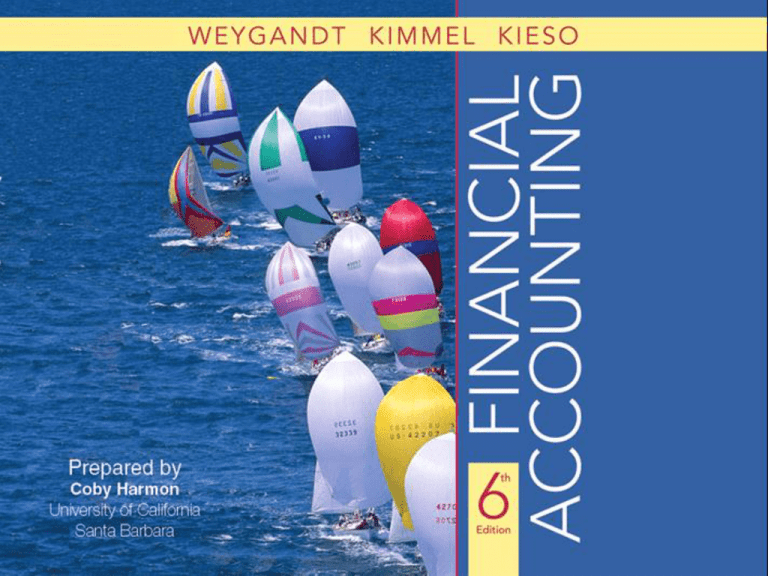
Chapter
14-1
Chapter
14
Statement of
Cash Flows
Financial Accounting, Sixth Edition
Chapter
14-2
Study Objectives
1. Indicate the usefulness of the statement of
cash flows.
2. Distinguish among operating, investing, and
financing activities.
3. Prepare a statement of cash flows using the
indirect method.
4. Analyze the statement of cash flows.
Chapter
14-3
Statement of Cash Flows
The Statement of
Cash Flows:
Usefulness and
Format
Usefulness
Classifications
Significant
noncash activities
Format
Preparation
Indirect and direct
methods
Chapter
14-4
Preparing the
Statement of
Cash Flows—
Indirect Method
Step 1: Operating
activities
Step 2: Investing
and financing
activities
Step 3: Net
change in cash
Using Cash
Flows to Evaluate
a Company
Free cash flow
Usefulness of the Statement of Cash Flows
Provides information to help assess:
1. Entity’s ability to generate future cash flows.
2. Entity’s ability to pay dividends and obligations.
3. Reasons for difference between net income and net
cash provided (used) by operating activities.
4. Cash investing and financing transactions during
the period.
Chapter
14-5
SO 1 Indicate the usefulness of the statement of cash flows.
Classification of Cash Flows
Operating
Activities
Income
Statement
Items
Chapter
14-6
Investing
Activities
Generally
Long-Term
Asset Items
Financing
Activities
Generally
Long-Term
Liability
and
Equity Items
SO 2 Distinguish among operating, investing, and financing activities.
Classification of Cash Flows
Classification of Typical Inflows and Outflows
Illustration 14-1
Operating activities - Income statement items
Cash inflows:
From sale of goods or services.
From interest received and dividends received.
Cash outflows:
To suppliers for inventory.
To employees for services.
To government for taxes.
To lenders for interest.
To others for expenses.
Chapter
14-7
SO 2 Distinguish among operating, investing, and financing activities.
Classification of Cash Flows
Classification of Typical Inflows and Outflows
Illustration 14-1
Investing activities - Changes in investments and longterm assets
Cash inflows:
From sale of property, plant, and equipment.
From sale of investments in debt or equity securities.
From collection of principal on loans to other entities.
Cash outflows:
To purchase property, plant, and equipment.
To purchase investments in debt or equity securities.
To make loans to other entities.
Chapter
14-8
SO 2 Distinguish among operating, investing, and financing activities.
Classification of Cash Flows
Classification of Typical Inflows and Outflows
Illustration 14-1
Financing activities - Changes in long-term liabilities
and stockholders’ equity
Cash inflows:
From sale of common stock.
From issuance of long-term debt (bonds and notes).
Cash outflows:
To stockholders as dividends.
To redeem long-term debt or reacquire capital stock.
Chapter
14-9
SO 2 Distinguish among operating, investing, and financing activities.
Classification of Cash Flows
Significant Noncash Activities
1. Issuance of common stock to purchase assets.
2. Conversion of bonds into common stock.
3. Issuance of debt to purchase assets.
4. Exchanges of plant assets.
Companies report these activities in either a separate
schedule at the bottom of the statement of cash flows
or in a separate note or supplementary schedule to the
financial statements.
Chapter
14-10
SO 2 Distinguish among operating, investing, and financing activities.
Format of the Statement of Cash Flows
Order of Presentation:
1.
Operating activities.
2.
Investing activities.
3.
Financing activities.
Direct Method
Indirect Method
The cash flows from operating activities section
always appears first, followed by the investing
and financing sections.
Chapter
14-11
SO 2 Distinguish among operating, investing, and financing activities.
Format of the Statement of Cash Flows
Illustration 14-2
Chapter
14-12
SO 2 Distinguish among operating, investing, and financing activities.
Preparing the Statement of Cash Flows
Three Sources of Information:
1. Comparative balance sheets
2. Current income statement
3. Additional information
Three Major Steps:
Chapter
14-13
SO 2 Identify the major classifications of cash flows.
Preparing the Statement of Cash Flows
Three Major Steps:
Chapter
14-14
SO 2 Identify the major classifications of cash flows.
Preparing the Statement of Cash Flows
Indirect and Direct Methods
Companies favor the indirect
method for two reasons:
1. It is easier and less costly
to prepare, and
2. It focuses on the
differences between net
income and net cash flow
from operating activities.
Chapter
14-15
SO 2 Identify the major classifications of cash flows.
Preparing the Statement of Cash Flows
Demonstration
Problem
Indirect
Method
Illustration 14-4
Chapter
14-16
SO 3 Prepare a statement of cash flows using the indirect method.
Preparing the Statement of Cash Flows
Demonstration
Problem
Indirect
Method
Illustration 14-4
Chapter
14-17
SO 3 Prepare a statement of cash flows using the indirect method.
Preparing the Statement of Cash Flows
Demonstration
Problem
Additional information for 2008:
Illustration 14-4
1.
2.
3.
4.
The company declared and paid a $29,000 cash dividend.
Issued $110,000 of long-term bonds in direct exchange for land.
A building costing $120,000 and equipment costing $25,000 were purchased for cash.
The company sold equipment with a book value of $7,000 (cost $8,000, less accumulated
depreciation $1,000) for $4,000 cash.
5. Issued common stock for $20,000 cash.
6. Depreciation expense was comprised of $6,000 for building and $3,000 for equipment.
Chapter
14-18
SO 3 Prepare a statement of cash flows using the indirect method.
Preparing the Statement of Cash Flows –
Indirect Method
Step 1: Operating Activities
Determine net cash provided/used by operating
activities by converting net income from an accrual
basis to a cash basis.
Common adjustments to Net Income (Loss):
Add back non-cash expenses (depreciation and
amortization expense).
Deduct gains and add losses.
Changes in current assets and current liabilities.
Chapter
14-19
SO 3 Prepare a statement of cash flows using the indirect method.
Step 1: Operating Activities
Question
Which is an example of a cash flow from an
operating activity?
a. Payment of cash to lenders for interest.
b. Receipt of cash from the sale of capital stock.
c. Payment of cash dividends to the company’s
stockholders.
d. None of the above.
Chapter
14-20
SO 3 Prepare a statement of cash flows using the indirect method.
Step 1: Operating Activities
Depreciation Expense
Although depreciation expense reduces net income, it
does not reduce cash. Depreciation is a noncash
charge. The company must add it back to net income.
Illustration 14-6
Cash flows from operating activities:
Net income
Adjustments to reconcile net income to net cash
provided by operating activities:
Depreciation expense
Net cash provided by operating activities
Chapter
14-21
$
145,000
$
9,000
154,000
SO 3 Prepare a statement of cash flows using the indirect method.
Operating Activities
Loss on Sale of Equipment
Because companies report as a source of cash in the
investing activities section the actual amount of cash
received from the sale:
Any loss on sale is added to net income in the
operating section.
Any gain on sale is deducted from net income in
the operating section.
Chapter
14-22
SO 3 Prepare a statement of cash flows using the indirect method.
Operating Activities
Loss on Sale of Equipment
Illustration 14-7
Cash flows from operating activities:
Net income
Adjustments to reconcile net income to net cash
provided by operating activities:
Depreciation expense
Loss on sale of equipment
Net cash provided by operating activities
Chapter
14-23
$
145,000
$
9,000
3,000
157,000
SO 3 Prepare a statement of cash flows using the indirect method.
Operating Activities
Changes to Noncash Current Asset Accounts
When the Accounts Receivable balance decreases, cash
receipts are higher than revenue earned under the
accrual basis.
Illustration 14-8
Accounts Receivable
1/1/08
Balance
Revenues
12/31/08 Balance
30,000
507,000
Receipts from customers 517,000
20,000
Therefore, the company adds to net income the amount
of the decrease in accounts receivable.
Chapter
14-24
SO 3 Prepare a statement of cash flows using the indirect method.
Operating Activities
Changes to Noncash Current Asset Accounts
Illustration 14-9
Cash flows from operating activities:
Net income
Adjustments to reconcile net income to net cash
provided by operating activities:
Depreciation expense
Loss on sale of equipment
Decrease in accounts receivable
Net cash provided by operating activities
Chapter
14-25
$
145,000
$
9,000
3,000
10,000
167,000
SO 3 Prepare a statement of cash flows using the indirect method.
Operating Activities
Changes to Noncash Current Asset Accounts
When the Inventory balance increases, the cost of
merchandise purchased exceeds the cost of goods sold.
Merchandise Inventory
1/1/08
Balance
Purchases
12/31/08 Balance
10,000
155,000
Cost of goods sold
150,000
15,000
As a result, cost of goods sold does not reflect cash
payments made for merchandise. The company deducts
from net income this inventory increase.
Chapter
14-26
SO 3 Prepare a statement of cash flows using the indirect method.
Operating Activities
Changes to Noncash Current Asset Accounts
Illustration 14-9
Cash flows from operating activities:
Net income
Adjustments to reconcile net income to net cash
provided by operating activities:
Depreciation expense
Loss on sale of equipment
Decrease in accounts receivable
Increase in inventory
Net cash provided by operating activities
Chapter
14-27
$
145,000
$
9,000
3,000
10,000
(5,000)
162,000
SO 3 Prepare a statement of cash flows using the indirect method.
Operating Activities
Changes to Noncash Current Asset Accounts
When the Prepaid Expense balance increases, cash paid
for expenses is higher than expenses reported on an
accrual basis. The company deducts the decrease from
net income to arrive at net cash provided by operating
activities.
If prepaid expenses decrease, reported expenses are
higher than the expenses paid.
Chapter
14-28
SO 3 Prepare a statement of cash flows using the indirect method.
Operating Activities
Changes to Noncash Current Asset Accounts
Illustration 14-9
Cash flows from operating activities:
Net income
Adjustments to reconcile net income to net cash
provided by operating activities:
Depreciation expense
Loss on sale of equipment
Decrease in accounts receivable
Increase in inventory
Increase in prepaid expenses
Net cash provided by operating activities
Chapter
14-29
$
145,000
$
9,000
3,000
10,000
(5,000)
(4,000)
158,000
SO 3 Prepare a statement of cash flows using the indirect method.
Operating Activities
Changes to Noncash Current Liability Accounts
When Accounts Payable increases, this means the
company received more in goods than it actually paid for.
The increase is added to net income to determine net
cash provided by operating activities.
When Income Tax Payable decreases, this means the
income tax expense reported on the income statement
was less than the amount of taxes paid during the period.
The decrease is subtracted from net income to
determine net cash provided by operating activities.
Chapter
14-30
SO 3 Prepare a statement of cash flows using the indirect method.
Operating Activities
Changes to Noncash Current Liability Accounts
Illustration 14-10
Cash flows from operating activities:
Net income
Adjustments to reconcile net income to net cash
provided by operating activities:
Depreciation expense
Loss on sale of equipment
Decrease in accounts receivable
Increase in inventory
Increase in prepaid expenses
Increase in accounts payable
Decrease in income taxes payable
Net cash provided by operating activities
Chapter
14-31
$
145,000
$
9,000
3,000
10,000
(5,000)
(4,000)
16,000
(2,000)
172,000
SO 3 Prepare a statement of cash flows using the indirect method.
Operating Activities
Summary of Conversion to Net
Cash Provided by Operating
Activities—Indirect Method
Chapter
14-32
Illustration 14-11
SO 3 Prepare a statement of cash flows using the indirect method.
Step 2: Investing and Financing Activities
From the additional information, the company purchased land
of $110,000 by issuing long-term bonds. This is a significant
noncash investing and financing activity that merits disclosure
in a separate schedule.
Land
1/1/08
Balance
Issued bonds
12/31/08 Balance
20,000
110,000
130,000
Bonds Payable
1/1/08
Chapter
14-33
Balance
For land
20,000
110,000
12/31/08 Balance
130,000
SO 3 Prepare a statement of cash flows using the indirect method.
Investing and Financing Activities
Illustration 14-13
Partial statement
Chapter
14-34
Net cash provided by operating activities
Cash flows from investing activities:
Purchase of building
Purchase of equipment
Sale of equipment
Net cash used by investing activities
Cash flows from financing activities:
Issuance of common stock
Payment of cash dividends
Net cash used by financing activities
Net increase in cash
Cash at beginning of period
Cash at end of period
172,000
$
20,000
(29,000)
(9,000)
22,000
33,000
55,000
Disclosure: Issuance of bonds to purchase land
$
110,000
(120,000)
(25,000)
4,000
(141,000)
SO 3 Prepare a statement of cash flows using the indirect method.
Investing and Financing Activities
From the additional information, the company acquired
an office building for $120,000 cash. This is a cash
outflow reported in the investing section.
Building
1/1/08
Balance
40,000
Office building 120,000
12/31/08 Balance
Chapter
14-35
160,000
SO 3 Prepare a statement of cash flows using the indirect method.
Investing and Financing Activities
Illustration 14-13
Partial statement
Chapter
14-36
Net cash provided by operating activities
Cash flows from investing activities:
Purchase of building
Purchase of equipment
Sale of equipment
Net cash used by investing activities
Cash flows from financing activities:
Issuance of common stock
Payment of cash dividends
Net cash used by financing activities
Net increase in cash
Cash at beginning of period
Cash at end of period
172,000
$
20,000
(29,000)
(9,000)
22,000
33,000
55,000
Disclosure: Issuance of bonds to purchase land
$
110,000
(120,000)
(25,000)
4,000
(141,000)
SO 3 Prepare a statement of cash flows using the indirect method.
Investing and Financing Activities
The additional information explains that the equipment
increase resulted from two transactions: (1) a purchase of
equipment of $25,000, and (2) the sale for $4,000 of
equipment costing $8,000.
Equipment
1/1/08
Balance
Purchase
12/31/08 Balance
Journal
Entry
Chapter
14-37
10,000
25,000
Equipment sold
8,000
27,000
Cash
Accumulated depreciation
Loss on sale of equipment
Equipment
4,000
1,000
3,000
8,000
SO 3 Prepare a statement of cash flows using the indirect method.
Statement
of Cash
Flows
Indirect
Method
Chapter
14-38
Cash flows from operating activities:
Net income
Adjustments to reconcile net income to net cash
provided by operating activities:
Depreciation expense
Loss on sale of equipment
Decrease in accounts receivable
Increase in inventory
Increase in prepaid expenses
Increase in accounts payable
Decrease in income taxes payable
Net cash provided by operating activities
Cash flows from investing activities:
Purchase of building
Purchase of equipment
Sale of equipment
Net cash used by investing activities
Cash flows from financing activities:
Issuance of common stock
Payment of cash dividends
Net cash used by financing activities
Net increase in cash
Cash at beginning of period
Cash at end of period
Illustration 14-13
$
145,000
9,000
3,000
10,000
(5,000)
(4,000)
16,000
(2,000)
172,000
(120,000)
(25,000)
4,000
(141,000)
$
20,000
(29,000)
(9,000)
22,000
33,000
55,000
SO 3 Prepare a statement of cash flows using the indirect method.
Investing and Financing Activities
The additional information notes that the increase in
common stock resulted from the issuance of new shares.
Common Stock
1/1/08
Balance
Shares sold
12/31/08 Balance
Chapter
14-39
50,000
20,000
70,000
SO 3 Prepare a statement of cash flows using the indirect method.
Investing and Financing Activities
Illustration 14-13
Partial statement
Chapter
14-40
Net cash provided by operating activities
Cash flows from investing activities:
Purchase of building
Purchase of equipment
Sale of equipment
Net cash used by investing activities
Cash flows from financing activities:
Issuance of common stock
Payment of cash dividends
Net cash used by financing activities
Net increase in cash
Cash at beginning of period
Cash at end of period
172,000
$
20,000
(29,000)
(9,000)
22,000
33,000
55,000
Disclosure: Issuance of bonds to purchase land
$
110,000
(120,000)
(25,000)
4,000
(141,000)
SO 3 Prepare a statement of cash flows using the indirect method.
Investing and Financing Activities
Retained earnings increased $116,000 during the year. This
increase can be explained by two factors: (1) Net income of
$145,000 increased retained earnings. (2) Dividends of
$29,000 decreased retained earnings
Retained Earnings
1/1/08
Dividends
29,000
Balance
Net income
12/31/08 Balance
Chapter
14-41
48,000
145,000
164,000
SO 3 Prepare a statement of cash flows using the indirect method.
Statement
of Cash
Flows
Indirect
Method
Chapter
14-42
Cash flows from operating activities:
Net income
Adjustments to reconcile net income to net cash
provided by operating activities:
Depreciation expense
Loss on sale of equipment
Decrease in accounts receivable
Increase in inventory
Increase in prepaid expenses
Increase in accounts payable
Decrease in income taxes payable
Net cash provided by operating activities
Cash flows from investing activities:
Purchase of building
Purchase of equipment
Sale of equipment
Net cash used by investing activities
Cash flows from financing activities:
Issuance of common stock
Payment of cash dividends
Net cash used by financing activities
Net increase in cash
Cash at beginning of period
Cash at end of period
Illustration 14-13
$
145,000
9,000
3,000
10,000
(5,000)
(4,000)
16,000
(2,000)
172,000
(120,000)
(25,000)
4,000
(141,000)
$
20,000
(29,000)
(9,000)
22,000
33,000
55,000
SO 3 Prepare a statement of cash flows using the indirect method.
Investing and Financing Activities
Question
Which is an example of a cash flow from an investing
activity?
a. Receipt of cash from the issuance of bonds
payable.
b. Payment of cash to repurchase outstanding
capital stock.
c. Receipt of cash from the sale of equipment.
d. Payment of cash to suppliers for inventory.
Chapter
14-43
SO 3 Prepare a statement of cash flows using the indirect method.
Using Cash Flows to Evaluate a Company
Free Cash Flow
Free cash flow describes the cash remaining from
operations after adjustment for capital expenditures
and dividends.
Chapter
14-44
SO 4 Analyze the statement of cash flows.
All About You
Where Does the Money Go?
Where do you spend your cash?
Some Facts:
College students spend about $200 billion per year
on consumer products. Of that amount, $41 billion
is “discretionary” in nature.
More than 70% of college students own a cell phone,
and 71% own a car.
Chapter
14-45
All About You
Where Does the Money Go?
More Facts:
College students spend more than $8 billion per
year purchasing DVDs, CDs, music downloads, and
video games.
Annual spending on travel by college students is
about $4.6 billion.
78% of college students work, earning an average of
$821 per month.
Chapter
14-46
All About You
College students spend an average of $287 per month on
discretionary items (defined as anything other than
tuition, room/board, rent, books, and school fees).
Source: “College
Students Spend $200
Billion per Year,”
HarrisInteractive,
www.harrisinteractive.
com/news/allnewsbyd
ate.asp?NewsID480
(accessed May 2006).
Chapter
14-47
All About You
What Do You Think?
Suppose your annual cash
flow statement includes
Should you get rid of your
car and cell phone, quit
eating snacks, and give up
the idea of a vacation?
X
Chapter
14-48
YES: At this rate you will accumulate nearly $40,000 in
debts by the time you graduate.
NO: Life wouldn’t be worth living if I couldn’t be
drinking a Starbucks while cruising down the road
talking on my cell phone.
Copyright
“Copyright © 2008 John Wiley & Sons, Inc. All rights reserved.
Reproduction or translation of this work beyond that permitted
in Section 117 of the 1976 United States Copyright Act without
the express written permission of the copyright owner is
unlawful. Request for further information should be addressed
to the Permissions Department, John Wiley & Sons, Inc. The
purchaser may make back-up copies for his/her own use only
and not for distribution or resale. The Publisher assumes no
responsibility for errors, omissions, or damages, caused by the
use of these programs or from the use of the information
contained herein.”
Chapter
14-49

